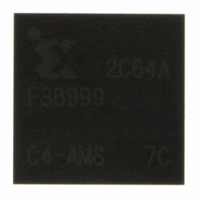XC2C64A-7CPG56C Xilinx Inc, XC2C64A-7CPG56C Datasheet - Page 12

XC2C64A-7CPG56C
Manufacturer Part Number
XC2C64A-7CPG56C
Description
IC CR-II CPLD 64MCELL 56-BGA
Manufacturer
Xilinx Inc
Series
CoolRunner IIr
Specifications of XC2C64A-7CPG56C
Programmable Type
In System Programmable
Delay Time Tpd(1) Max
6.7ns
Voltage Supply - Internal
1.7 V ~ 1.9 V
Number Of Logic Elements/blocks
4
Number Of Macrocells
64
Number Of Gates
1500
Number Of I /o
45
Operating Temperature
0°C ~ 70°C
Mounting Type
Surface Mount
Package / Case
56-CSBGA
Features
Programmable
Voltage
1.8V
Memory Type
CMOS
For Use With
122-1536 - KIT STARTER SPARTAN-3E122-1532 - KIT DEVELOPMENT SPARTAN 3ADSP
Lead Free Status / RoHS Status
Lead free / RoHS Compliant
Number Of Logic Elements/cells
-
Other names
122-1408
Available stocks
Company
Part Number
Manufacturer
Quantity
Price
Company:
Part Number:
XC2C64A-7CPG56C
Manufacturer:
XILINX
Quantity:
332
Part Number:
XC2C64A-7CPG56C
Manufacturer:
XILINX/赛灵思
Quantity:
20 000
CoolRunner-II CPLD Family
Programming
The programming data sequence is delivered to the device
using either Xilinx iMPACT software and a Xilinx download
cable,
JTAG-compatible board tester, or a simple microprocessor
interface that emulates the JTAG instruction sequence. The
iMPACT software also outputs serial vector format (SVF)
files for use with any tools that accept SVF format, including
automatic test equipment. See
Application Notes
In System Programming
All CoolRunner-II CPLD parts are 1.8V in system program-
mable. This means they derive their programming voltage
and currents from the 1.8V V
pins on the part. The V
operation, as they might assume another voltage ranging as
high as 3.3V down to 1.5V (however, all V
V
be programmed, and operate correctly). A 1.8V V
required to properly operate the internal state machines and
charge pumps that reside within the CPLD to do the nonvol-
atile programming operations. I/O pins are not in user mode
during JTAG programming; they are held in 3-state with a
weak pullup. The JTAG interface buffers are powered by a
dedicated power pin, V
other supply pins. V
ware is provided to deliver the bitstream to the CPLD and
drive the appropriate IEEE 1532 protocol. To that end, there
is a set of IEEE 1532 commands that are supported in the
CoolRunner-II CPLD parts. Programming times are less
than one second for 32 to 256 macrocell parts. Program-
ming times are less than four seconds for 384 and 512 mac-
rocell parts. Programming of CoolRunner-II CPLDs is only
guaranteed when operating in the commercial temperature
and voltage ranges as defined in the device-specific data
sheets.
On-The-Fly Reconfiguration (OTF)
The Xilinx ISE 5.2i tool supports OTF for CoolRunner-II
CPLDs. This permits programming a new nonvolatile pat-
tern into the part while another pattern is currently in use.
OTF has the same voltage and temperature specifications
as system programming. During pattern transition I/O pins
are in high impedance with a weak pullup to V
tion time typically lasts between 50 and 300 μs, depending
on density. See
JTAG Instructions
Table 7
same commands can be used by third party ATE products,
12
CCAUX
, and GND pins must be connected for the device to
a
shows the commands available to users. These
third-party
XAPP388
for more information on how to program.
CCAUX
CCAUX
CCIO
JTAG
for more information.
must be connected. Xilinx soft-
pins do not participate in this
, which is independent of all
CC
development
(internal supply voltage)
CoolRunner-II CPLD
CCIO
CCIO
system,
, V
. Transi-
CCINT
www.xilinx.com
CC
is
a
,
as well. The internal controllers can operate as fast as
66 MHz.
Table 7: JTAG Instructions
Power-Up Characteristics
CoolRunner-II CPLD parts must operate under the
demands of both the high-speed and the portable market
places; therefore, they must support hot plugging for the
high-speed world and tolerate most any power sequence to
its various voltage pins. They must also not draw excessive
current during power-up initialization. To those ends, the
general behavior is summarized as follows:
1. I/O pins are disabled until the end of power-up.
2. As supply rises, configuration bits transfer from
3. As power up completes, the outputs become as
4. For specific configuration times and power up
CoolRunner-II CPLD I/O pins are well behaved under all
operating conditions. During power-up, CoolRunner-II
devices employ internal circuitry which keeps the devices in
the quiescent state until the V
safe level (approximately 1.3V). In the quiescent state,
JTAG pins are disabled, and all device outputs are disabled
with the pins weakly pulled High, as shown in
the supply voltage reaches a safe level, all user registers
become initialized, and the device is immediately available
for operation, as shown in
obtained with a smooth V
V
If the device is in the erased state (before any user pattern
is programmed), the device outputs remain disabled with a
weak pull-up. The JTAG pins are enabled to allow the device
00000000
00000011
11111111
00000010
00000001
11111101 USERCODE Read USERCODE
11111100
11111010
CC
Code
nonvolatile memory to SRAM cells.
configured (input, output, or I/O).
requirements, see XAPP389.
value should occur within 1 second.
Instruction
PRELOAD
EXTEST
BYPASS
IDCODE
INTEST
CLAMP
HIGHZ
CC
Force boundary scan data onto
outputs
Latch macrocell data into
boundary scan cells
Insert bypass register between
TDI and TDO
Force boundary scan data onto
inputs and feedbacks
Read IDCODE
Force output into high
impedance state
Latch present output state
DS090 (v3.1) September 11, 2008
Figure
rise in less than 4 ms. Final
CCINT
supply voltage is at a
Description
12. Best results are
Product Specification
Table
8. When
R














